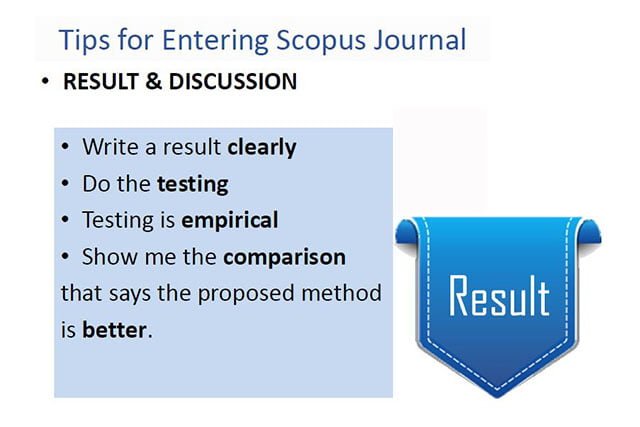Last Updated on July 12, 2023
Well, now you will enter into the most important and easiest to write. Why is that? Because in writing the Results and Discussion you will convey the results of your research. If you can convey the results of your research well, then the reader will find and understand the essence of your research easily. This section is also the easiest part to write because you know very well how the results you get.
However, sometimes you feel confused about how to write good Results and Discussions right? What kind of information needs to write down? How to write it? And so on. Sometimes when you can’t write the result and the discussion correctly, research with a good result can be dubious.
Therefore, let’s look at tips on how to write results and the following discussion to improve your skills!
Results
The Results section is where you report your research findings based on the methodology you apply. The results section must state the research findings arranged in a logical order without bias or opinion. The section describing the results is very necessary if your paper includes data generated from your own research. Important things in writing a Result are:
- Written in the order of the methodology you use.
- Write data interpretations that are easy to understand. Here you can explain the simple conclusions from the results obtained. While the data can write in tabular form that displays all or part of the data used.
- There is no opinion.
- Image representation from the results of research is very necessary, at least 1 picture per page.
- Results Representation of the research in the table is also very necessary, at least 1 table per page.
- Write explanations of the figures and tables clearly. Each figure and table must refer to and have an explanation in the paragraph.
Detailed Explanation About Results
If the journal you are targeting requires that the Result and Discussion sections must be separate, then follow that writing method. Keep in mind, the author’s opinion also should not write in the Result section. Opinions can express when writing a Discussion. Content must be 100% unbiased data interpretation and research results.
However, some journal has a Results & Discussion template combined. If so, the data interpretation content, result, and discussion can be put together. Therefore, the writing structure will be as follows:
- Data Interpretation
- Research Result
- Discussion based on related references.

Additional information
What is the difference between reading data and interpreting data? I have examples from several sources about the differences between the two, namely:
Examples of Reading Data
Statistical analysis showed that group A had a value of 9.9 while group B had a value of 8.0. These results are in Table 1.
Examples of Data Interpretation
The result of the analysis of statistical data calculations shows that the average value of group A is higher than group B with a significant difference. More detailed results regarding statistical calculations can be seen in Table 1.
When you write “data readings”, the reader won’t understand what the data means. However, if what is you write the “data interpretation”, then the reader will understand what the data means. Besides, please avoid words that are too general and overly exaggerate data. Keep in mind again, for the result avoid the first writing the opinion of the author.
Example of Unclear Explanation
Mutations were detected in almost all samples.
Well, the above sentence is not clear. The word “almost all over” is almost 100%. Though not necessarily because this sentence is subjective.
Example of Clear Explanation
Mutations were detected in 99 samples out of a total of 106 analyzed samples.
In addition to delivering research results, the results section must also display testing results. The testing result will use to provide evidence that your research has reached the target formulated. On the other hand, it can prove that your result is better than previous research.
Discussion
The purpose of this Discussion is to interpret and describe the importance of your findings. The discussion will explain the new understanding or insight that arises as a result of your study of the problem. Discussions will always connect to the introduction through research questions. It also connects with problem formulation or the hypotheses you submit and the literature you review.

The Discussion section is the most important part. In the Discussion stage, the researcher need to discuss the results of the research base on today’s references. In this section, you can write your opinion. However, the opinion is derived from the facts that you find from reading the references. Because this section must be full of references, I suggest you use your published paper with a related theme (preliminary research) as a reference.
It can also be a trick that supports the results of research that is currently done to be as if better than previous research. Besides, your paper that has published its citation score can increase (the more it cites), and also the editor can see the progress of your research progress. This is important to show that your research is not making it up, falsification, engineering, and so on. But it should be noted again that according to the Journal Ranking self-citation is a maximum of 10% percent of the total reference.
(Read Also: Tutorial on Insert Citation and Bibliography Using Mendeley Desktop)
Rules for Writing a Discussion
- Write down the response of each result, but not rewrite the data.
- Use references that belong to you, your colleagues, or other parties.
- Write down the facts of the results, but don’t be hyperbolic.
- Avoid writing non-specific expressions, such as “higher temperature”, “very significant”, “at a lower level”. Use preferred quantitative descriptions such as “Temperature 29 degrees Celsius”, “Increase by 50%”, “p<1000”, etc.
- Avoid using new terms suddenly. Therefore, the discussion should be always connect with the introduction.
- Speculation about possible interpretations is permissible, but there must be an underlying source and not the author’s delusion.
Example of Writting a Discussion
The following example you can follow in writing results that refer to references with the IEEE style.
4.6 Comparison of Prediction Results
The results of the rainfall prediction using the hybrid Tsukamoto FIS and GA method were compared with the prediction results from previous studies conducted by Wahyuni and Mahmudy [2] and Iriany, et al. [3]. The standard of comparison used was the predicted RMSE value for each location. The comparison is shown in Table 11.
From Table 11 it can be seen that the result of rainfall prediction using the hybrid method produced lower predicted RMSE values for the four areas of Puspo, Sumber, Tosari, and Tutur when compared with the results predicted by the Tsukamoto FIS algorithm alone. The hybrid method also generated a smaller RMSE at Tosari and Tutur area when compared with the prediction results using the GSTAR-SUR method. The RMSE difference in the Sumber area using the GSTAR-SUR method was only better by 0.4 than the RMSE using the hybrid method. However, the predictions showed that the hybrid method generally produced better predictions indicated by the smaller RMSE values.
Rainfall Prediction in Tengger, Indonesia Using Hybrid Tsukamoto FIS and Genetic Algorithm Method
Ida Wahyuni, Wayan Firdaus Mahmudy
Additional Information
Some authors misunderstand and assume that the discussion section only addresses positive or good research results, even though they are not. If you have negative research results, for example, the results of your research accuracy are worse than previous studies. You still need to write those results in the paper and explain why this could happen. You need to explain it in a good direction to help the reviewer achieve the non-perfect result. Then, even your result is worst compared with the previous study, it is still worthy to publish.

Use these tips, because I’ve experienced them. I have published a paper with some of the worse results from previous research. However, because I pack the sentence neatly, finally my research seemed to look better. You can see an example in Figure 3 or more complete reading my paper with the title: Rainfall Prediction in Tengger, Indonesia Using Hybrid Tsukamoto FIS and Genetic Algorithm Method.
For more information read also 7 Tips and Tricks for Publish in Scopus Journal.
Important Info: Do not forget to check the Journal Guideline or Author Guideline in each journal. In a reputable journal, the first selection is the scope of the topic. Then they will see the paper template is correct or not. If the paper template does not match the journal template you are aiming for, then your paper will definitely be rejected even before it is reviewed.
Related Article
To improve your writing skills, you can follow some guidelines in writing each section in the following article.
- Introduction to Structure of Scientific Paper
- 4 Important Points in Writing Abstract on Scientific Paper
- 5 Important Point To Make A Good Introduction
- Previous Research Writing Guidelines
- Methodology Writing Guideline
- Guideline for Writing Conclusions in Scientific Paper
- References Writing Guideline
Lastly, this is the explanation in the video version.
References
http://libguides.usc.edu/writingguide/discussion
http://libguides.usc.edu/writingguide/results
Author: Ida Wahyuni
Instagram Direct Message: @idawahyuni92




apa tips yg harus dilakukan sebelum membuat hasil tulisan dan diskusi bersama kelompok?
Hi kak, disini saya akan menjawab dalam Bahasa Indonesia:
Tentu cara penulisannya tidak jauh berbeda. Karena sebagian besar penelitian memang dilakukan lebih dari satu orang (kelompok). Jadi yang ditulis dalam hasil dan pembahasan adalah hasil diskusi atau penemuan bersama dari anggota penelitian (kelompok diskusi).